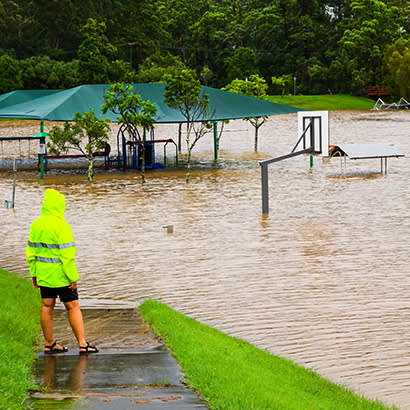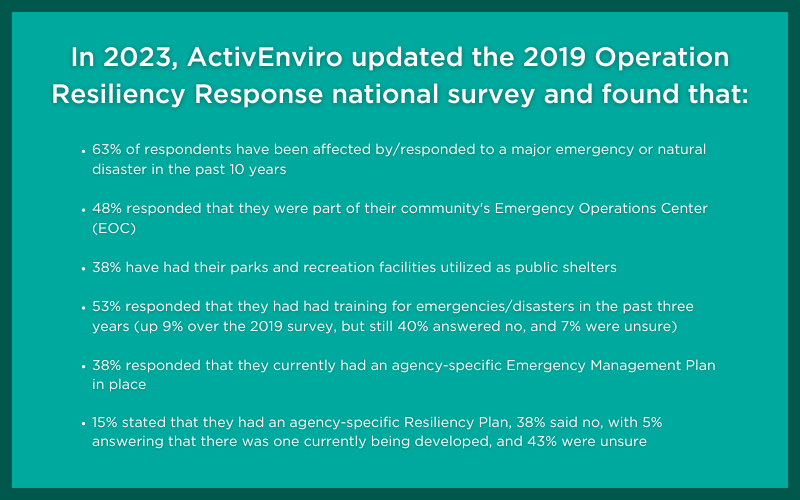
Hurricanes, wildfires, tornadoes, floods and other extreme weather events have become far too common. Chances are that if you have not been personally affected by one of these types of events recently, you will be soon. Are you and your agency prepared? September is Disaster Preparedness Month — the perfect time to prepare for disaster response and recovery.
The Role of Parks and Recreation in Disaster Response
In 2019,ActivEnviro (formerly GP RED) and RRC Associates conducted a national survey of parks, recreation, and allied professionals and educators to explore the role of park and recreation agencies in disaster response and recovery, with guidance from the Operation Resiliency Response (ORR). Key findings included:
- Local park and recreation agencies play a significant role in disaster response, recovery and management, specifically related to physical, mental and environmental health.
- The majority of agencies that responded have been affected by major disasters.
- The majority of agencies that responded had not received training or preparation for a natural disaster in the last three years.
"Resilience to disasters is increased when the societal impacts of disasters are reduced."
- Davies & Davies, 2018
The services that park and recreation agencies provide in a community are essential. The more stressed or overwhelmed an individual is, the more our services are needed, especially in times of disaster. Parks and public lands are key to the mitigation of disaster impacts. During a disaster, park and recreation facilities are safe public places that residents can go to for help. Following a disaster, the re-opening of parks, recreation facilities, programs and community trails plays an important role in the recovery of a community. Re-instating programs and services often signifies a “return to normalcy” to impacted residents, providing avenues for stress reduction and community connections. If an agency is not prepared for disaster, the community is not prepared.

Where Are We Now
Natural disasters can be vivid reminders of the vulnerability of community health. The social ties that develop through community change efforts improve health outcomes and are critical for surviving and recovering from tragedies. Too often the under-resourced populations in our communities are most affected. Mitigation of climate change and the resultant potential natural disasters, soil erosion and other actions are ways agencies can leverage actions, minimize financial impacts and help prepare.
Very few people like to think about disasters. If you have been through one, it can be triggering, bringing up horrible memories you would just as soon forget. If you have not experienced one, it can be hard to think about what might happen. All park and recreation agencies need to become more resilient. By taking proactive measures to mitigate climate change and the resultant potential natural disasters, agencies can minimize financial impacts and better prepare for future challenges. In 2017, NRPA created a report, Park and Recreation Sustainability Practices: A Summary Of Results From An NRPA Member Survey. The report identified a variety of strategies for how park and recreation agencies can be more sustainable, and the cost savings generated from sustainability activities.
As community leaders, we need to focus on the three aspects of readiness and reaction:
- Prepare – Do you have the documentation and plans ready in advance?
- Respond – During an event, are team members ready to do what needs to be done?
- Recover – Can your community quickly restore to normalcy?
The best way to recover is to plan ahead so your parks and facilities are designed and updated to weather, withstand and handle disasters. When you are building or updating your assets and programs, incorporate disaster and resiliency planning as much as possible, in advance. The more you are ready, the more quickly you’ll be able to mobilize and get funding to rebuild and help the community return to normal.
Resources to Help
Numerous resources are available from the American Red Cross and the Federal Emergency Management Agency (FEMA) to assist individuals and agencies at the federal level. However, it is very important to create a community-specific plan and provide tailored training for your agency, staff and community to ensure preparedness that meets local needs.
To help with this, Donna Kuethe, CPRP, has led efforts with over 40 other thought leaders since 2006 to create resources specifically to help agencies and park and recreation professionals be better prepared. The Operation Resiliency Response (ORR) Manual is now available in both digital and paperback formats for purchase on Amazon. Agency-specific training and facilitation of preparedness and response aspects are also available from ActivEnviro staff and trained volunteers.
Focusing on creating good plans, updating inventories and incorporating sustainable and resilient designs in your planning will go a long way. Support and training are readily available, so don’t delay in taking action!
Teresa L. Penbrooke, PhD, CPRE, has more than 30 years of experience in parks and recreation management, programming, planning, consulting, research, and education. She currently works as the Executive Director for ActivEnviro (formerly GP RED), a consultant for BerryDunn, and is Faculty for the Parks and Recreation Emerging Professionals Program (PREPP) for University of Colorado-Denver School of Public Affairs Institute. Dr. Penbrooke can be reached at teresap@ActivEnviro.org.
Davies, T.R.H, and Davies, A.J. (2018). Increasing communities’ resilience to disasters: An impact-based approach. International Journal of Disaster Risk Reduction. 31: Pp. 742-749


